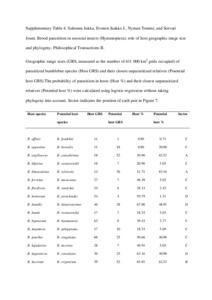Brood parasitism in eusocial insects (Hymenoptera): role of host geographical range size and phylogeny
Suhonen J; Ilvonen JJ; Nyman T; Sorvari J
https://urn.fi/URN:NBN:fi-fe2021042822246
Tiivistelmä
Interspecific brood parasitism is common in many animal systems. Brood parasites enter the nests of other species and divert host resources for producing their own offspring, which can lead to strong antagonistic parasite–host coevolution. Here, we look at commonalities among social insect species that are victims of brood parasites, and use phylogenetic data and information on geographical range size to predict which species are most probably to fall victims to brood parasites in the future. In our analyses, we focus on three eusocial hymenopteran groups and their brood parasites: (i) bumblebees, (ii) Myrmica ants, and (iii) vespine and polistine wasps. In these groups, some, but not all, species are parasitized by obligate workerless inquilines that only produce reproductive-caste descendants. We find phylogenetic signals for geographical range size and the presence of parasites in bumblebees, but not in ants and wasps. Phylogenetic logistic regressions indicate that the probability of being attacked by one or more brood parasite species increases with the size of the geographical range in bumblebees, but the effect is statistically only marginally significant in ants. However, non-phylogenetic logistic regressions suggest that bumblebee species with the largest geographical range sizes may have a lower likelihood of harbouring social parasites than do hosts with medium-sized ranges. Our results provide new insights into the ecology and evolution of host–social parasite systems, and indicate that host phylogeny and geographical range size can be used to predict threats posed by social parasites, as well to design efficient conservation measures for both hosts and their parasites.
This article is part of the theme issue ‘The coevolutionary biology of brood parasitism: from mechanism to pattern’.
Kokoelmat
- Rinnakkaistallenteet [27094]
